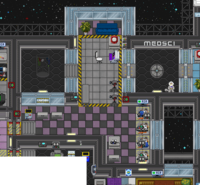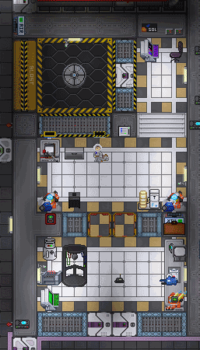Difference between revisions of "Telescience"
(Added a tip and some info on Z-levels) |
Studenterhue (talk | contribs) m |
||
| Line 2: | Line 2: | ||
Note that abusing the teleporter to steal everything that's not nailed down when you're not the traitor will land you in a world of trouble. | Note that abusing the teleporter to steal everything that's not nailed down when you're not the traitor will land you in a world of trouble. | ||
== Holy shit, this is just like Star Trek! == | == Holy shit, this is just like Star Trek! == | ||
[[File:TelescienceLab.png|200px|right|thumb|Telescience laboratory]] | [[File:TelescienceLab.png|200px|right|thumb|Telescience laboratory on [[Cogmap2]]]] | ||
[[File:DestinyTelescience.png|200px|right|thumb|Telescience laboratory on [[Destiny]]]] | |||
=== A word of warning === | === A word of warning === | ||
Revision as of 23:49, 2 March 2017
The teleporter lab, not to be confused with the Teleporter Room, is where scientists go to conduct telescience. This involves plotting coordinates into a computer in order to send or receive items through the teleporter pad. With practice, you can pick up items from a specific tile anywhere on the station and even deep space.
Note that abusing the teleporter to steal everything that's not nailed down when you're not the traitor will land you in a world of trouble.
Holy shit, this is just like Star Trek!


A word of warning
Before we get into the actual mechanics, there are a few things you should know. Firstly, using the teleporter successfully requires a decent grasp of basic, linear algebra. Secondly, randomly plotting in coordinates may trigger anything from violent bursts of flame and paralyzing explosions to monster invasions. This is why you should keep a fire extinguisher at hand and consider lowering the blast doors to the teleportation pad.
Teleporter Console functions
Send: This will send one object on the teleporter pad to the selected destination. Multiple objects will require multiple pressed of the Send button.
Receive: Same deal as Send, but brings things from the destination to the teleporter pad instead.
Toggle Portal: Spawns a portal on both the pad and the destination, allowing people to freely move between areas. Also warps everything that was on the tile when the portal was formed.
Scan: Scan the area to see if its destination is valid, and if so, what kind of atmosphere it has (if any at all).
Bookmark: Saves the current set of coordinates to the console, letting you bring it back up with a touch.
Operating the teleporter
When you enter coordinates into the targeting computer, it alters them through a function following the form of "t=mb+c" where B is what you put in, T is what it results in, and M and C are constants you have to solve for. Note that the computer alters X and Y coordinates separately, so their functions will be different! This math formula changes every round, and is different for every computer (so if telescience gets bombed, you'll have to do the algebra again). The Z coordinate identifies the map. The Z coordinates change every round, but the debris field Z-level is always one more than the Z-level containing the Adventure Zone, which is always one more than the station Z-level. Two ways to confirm for sure which one is which is to either use coordinates of known landmarks, or send a GPS through to valid coordinates, and check its location with another GPS.
Decoding the teleporter
The basic thought of the procedure is to grab a couple GPS units and start solving systems of equations.
- Pick up two GPS units, and reassign the identifier on one of them to something easily noticeable, like 'TELE' or 'TEST'. Optionally, name your personal GPS 'BASE' or 'MINE' or something.
- Drop the test GPS on the teleporter pad, then walk over to the teleport computer. Be sure to close the seal around the teleporter; failed teleports can sometimes cause nasty blowbacks like an eruption of flame, and you don't want that on you.
- Input random X, Y, and Z coordinates. X=50, Y=50, Z=5 is a good place to start. Don't try to start at 0/0/0 because the teleport is likely to be invalid, which will cause Bad Things. If you get an invalid teleport message, wait a second or two to make sure you're not about to suffer any ill effects. When things are calm, adjust the coordinates that were said to be invalid and try again.
- After the teleport happens, use your personal GPS to get the coordinates for where the test GPS ended up. Write these coordinates down.
- Click 'Receive' on the teleporter to retrieve your test GPS.
- Increase the computer's X and Y inputs by 1. Send the test GPS again.
- Read the coordinates off your personal GPS and write the coordinates down.
Using this data, you can figure out the 'm' constant by simply looking at how much the coordinate changed. So if your first test resulted in coordinates (40,59) and your second test resulted in the coordinates (45, 61), you know that 'm' is 5 in the equation for the X coordinate, and 'm' is 2 in the equation for the Y coordinate.
Using this new data, you can then solve for the 'c' factor in both equations. The math is simple enough to be put into a spreadsheet, so if you find yourself annoyed at the time this takes, make your computer do it for you!
A Decoding Example
This is a concrete example of decoding the teleporter.
First test:
Input: X=35, Y=43
Result: X=131, Y=120
Second test:
Input: X=36, Y=44
Result: X=134, Y=124
Solve for 'm' factors:
X equation: ![]()
Y equation: ![]()
Solve for 'c' factors:
X equation: ![]()
Y equation: ![]()
Final equations:
X equation: ![]()
Y equation: ![]()
Or, rearranged to how you'd actually use it (since you know the X and Y you want):
X equation: ![]()
Y equation: ![]()
Advanced use
- Cyborgs are able to use the teleporter computer remotely. This allows them to send themselves through the telepad and back without a partner.
- Anyone lost in space with a GPS can be saved, provided you've figured out the random elements of the coordinates.
- You can click the number in the Telescience computer directly to input even mixed numbers, such as 107.25 or 85.5. This is useful when your m factor is not 1.
A few tips
- Use the "Scan" function before teleporting your test GPS or if you're just unsure if it's a safe place or not. This way you'll be safely told if your test destination is invalid (among other Bad Things, warping with an invalid location can result in the GPS being sent to a random tile, which can make retrieving it needlessly complicated) or otherwise harmful (places with very hot temperature readings should be avoided, as you may be teleporting the GPS straight into the hot loop or a pool of lava, destroying it).
- While it would make sense for the Helmet Cam to be worn, its real purpose is to be sent through the teleporter so you can use the nearby monitor to view the area you just sent the helmet to (and not wearing it makes it easier to retrieve if no one runs off with it). This is essential for finding safe places to send people going on telescience adventures.
- Try not to leave portals on for extended periods of time. Aside from being a massive energy hog, they will randomly cause issues with the teleporter pad as if you'd entered invalid coordinates while they're left open.
- If you're going on an adventure and are afraid you can't trust the person operating the teleporter console to receive/portal you back, bug the Research Director for his Port-A-Sci remote. If you're the Research Director, your PDA has a Port-A-Sci program built in.
- While the mathematics for the telescience computer and the z-coordinates change every round, the general X and Y coordinates of places do not. It pays to write down the GPS-given X and Y coordinates of places you've discovered, so finding them again in later rounds is much less of a chore.
- If the teleporter computer and the telepad are displaying error messages, try checking the teleporter room's APC for power issues. If everything seems to be powered, the mainframe may be down, and you'll have to bug someone to reboot it. Keep in mind that every time the mainframe is reset, the offsets for the teleporter change.
Quantum Telescope
The quantum telescope is yet another fancy device at your disposal! It works with the Experimental long-range teleporter by providing coordinates to it. It's mechanics are very simple. You select and object on the right side of the screen and attempt to triangulate the location of said object. It provides the distance to the target when you scan, to use in triangulation. However, it is securely located in the RD's office because it's so darn cool.
Evil Genius Section
Traitor uses
Congratulations, you are a traitor scientist and the world is literally at your fingertips. As if bomb making and other science mischief wasn't enough, the potential uses for the teleporter are many. Remote theft, remote arson, remote bombing, remote kidnapping? There's remotely nothing you can't do. Just keep in mind that "bases" that belong to other antagonist roles (such as the Space Wizard and Syndicate shuttles) are hidden away on z-levels, completely impenetrable by any means and will simply fizzle the teleporter's feeble attempts to teleport in there.